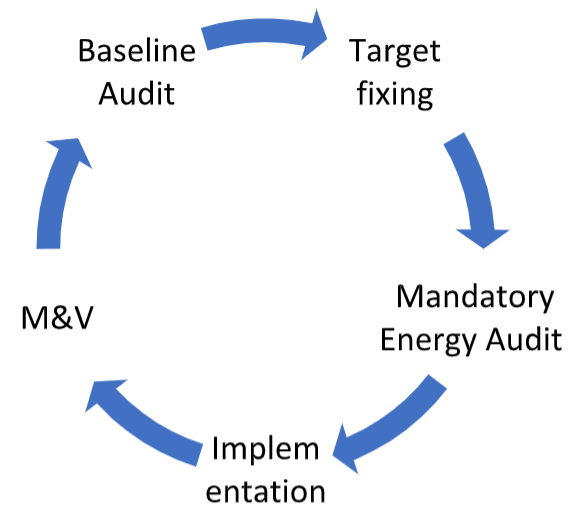BEE PAT Services
The National Action Plan on Climate Change (NAPCC) outlines eight national missions representing multipronged, long term, and integrated strategies for achieving key goals in the context of climate change. The National Mission for Enhanced Energy Efficiency (NMEEE) is one of the eight national missions with the objective of promoting innovative policy and regulatory regimes, financing mechanisms and business models which not only create, but also sustain markets for energy efficiency in a transparent manner with clear objectives to be achieved in a time bound manner. One of the main initiatives under NMEEE is the PAT Mechanism which is a market based mechanism to enhance cost effectiveness of improvements in energy efficiency in energy intensive large industries and facilities, through certification of energy savings that could be traded.
Perform Achieve and Trade(PAT):
A regulatory instrument to reduce specific energy consumption in energy intensive industries, with an associated market based mechanism to enhance the cost effectiveness through certification of excess energy saving which can be traded.

Enspar covers the entire aspect of the PAT mechanism (Typical PAT cycle)
PAT Services:
- Detailed Mandatory Energy Audit
- PAT Facilitation
- Analysis of Form-1 submissions
- Gate to Gate SEC determination
- Normalization applicability
- PAT Documentation
- Liaision with SDA and BEE
- Development of Energy Roadmap
- Annual Form-1 submission to BEE
- Energy Training/Workshop
- Monitoring Visit: Energy Initiatives
- Pro-forma filing: Monitoring and Verification Audit
- Preparing plant team for Monitoring
- PAT M&V
M&V
The Perform, Achieve and Trade (PAT) scheme is one of the initiatives under NMEEE, which was notified on 30 March, 2012. PAT is a market assisted compliance mechanism, designed to accelerate cost-effective improvements in energy efficiency in large energy-intensive industries, through certification of energy savings that can be traded. PAT flows out of the Energy Conservation Act, 2001 (amended in 2010). A robust monitoring, reporting and verification process will ensure effective and credible assessment of energy efficiency achieved by industries covered under PAT. A reliable monitoring and verification (M&V) system forms the backbone of PAT’s assessment process. Its objective is to streamline the process to verify the energy efficiency of a designated consumer in the target year. Verification involves independent evaluation of each activity the designated consumer undertook to comply with energy reduction targets. Verification plays a crucial role in maintaining the integrity of PAT and ensuring transparent validation.
PAT M&V will be carried out by a team of accredited energy auditor, process expert, certified energy auditor and an energy analyst. The documents submitted by the designated consumers to BEE will be reviewed and signed off by the accredited energy auditor.
The outcome of M&V is to verify whether the DC has achieved its target. The DC's which have achieved the target can trade ESCerts (Energy Saving Certificates).
Mandatory Energy Audit
As per Bureau of Energy Efficiency (Manner and Intervals of Time for Conduct of Energy Audit) Regulations, 2010, the first mandatory energy audit to be conducted by an Accredited Energy Auditor within 18 months time from the date of notification ( i.e. 27th May,2014) issued by the Central Government. The interval of time for conduct and completion of subsequent energy audits shall be three years with effect from the date of submission of the previous energy audit report by the accredited energy auditor to the management of the designated consumer.
Energy audit would be conducted to verify the energy data, establish specific energy consumption, identify major energy using equipment, processes and systems, data collection, monitoring and analysis, verification of data accuracy, conduct measurements, recommendations on energy saving measures and submitting an energy audit report.
The outcome will be an action plan for the energy saving measures.
Implementation
Implementation of the energy saving measures would be done which may involve operational improvements, controls and automation or equipment or technological changes.
The process involves techno-economic feasibility study of the proposal, solution design, basic and detailed engineering, monitoring and control strategies and automation systems, commissioning and implementation support.
Enspar has sector experts for the following sectors:
The sector experts have an average experience of over 35 years with extensive knowledge on each sector.- Pulp and Paper
- Thermal Power Plants
- DISCOM
- Iron and Steel
- Cement
- Textile
- Commercial Buildings
- Refineries
- Railways
- Commercial Buildings(Hotels)
looking for a BEE accredited energy auditing firm?
Enspar Energy Solutions can assist you with Mandatory Energy Audits, PAT advisory, PAT M&V audits, ESCert trading services